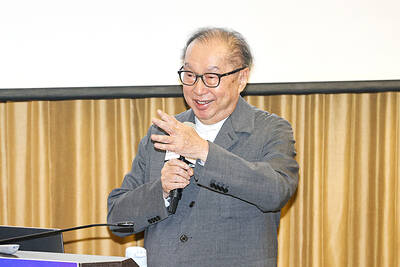After two decades in development, chipmakers are making a costly bet on a technology that will cram even more transistors onto silicon. Their success might hinge on a little-known company in the suburbs of Tokyo.
Lasertec Corp is the world’s sole maker of equipment that tests glass squares slightly bigger than a CD case that act as a stencil for chip designs.
By shining light through the squares, circuits smaller than the width of a few strands of DNA are imprinted onto silicon wafers in a process called lithography. These templates have to be perfect: Even a tiny defect can make every single chip in a batch unusable.
Consumers take it for granted that gadgets will keep getting slimmer, more powerful and cheaper, but the chip companies are running out of ways to etch ever-smaller circuit patterns onto silicon.
After years of setbacks, the industry has settled on extreme ultraviolet (EUV) lithography, which uses plasma as the light source to draw lines smaller than 7-nanometers. That is the size used in Apple Inc’s A12 Bionic chip featured in the iPhone XS and XR.
In 2017, Yokohama, Japan-based Lasertec solved the final piece of the puzzle when it created a machine that can test blank EUV masks for internal flaws, giving it a monopoly. The company’s stock has tripled since then.
Lasertec has already received orders totaling ¥4 billion (US$35.9 million) for machines that test EUV blanks, president Osamu Okabayashi said.
The company might see additional sales as soon as this summer, depending on how quickly Taiwan Semiconductor Manufacturing Co (TSMC, 台積電) and Samsung Electronics Co ramp up mass production, he said.
Lasertec on Tuesday closed 5.2 percent higher in Tokyo trading, the biggest gain since the start of this month.
“We spent six years developing this equipment,” Okabayashi said in an interview. “At this point, it’s become an industry standard and it would be very difficult for somebody else to enter the space.”
An EUV mask, a sandwich of about 80 alternating layers of silicon and molybdenum, can fetch as much as US$100,000.
Only two companies — glassmakers Hoya Corp and AGC Inc, both based in Japan — manufacture the blanks.
Lasertec’s machines can spot problems early on, which is critical to making the technology cost competitive.
“For EUV, masks have to be perfect,” Okabayashi said.
EUV lithography is so complex and expensive that only TSMC and Samsung have said that they will use it to move to 7-nanometer chipmaking.
Intel Corp has delayed its introduction, while difficulties in making EUV economically viable have prompted GlobalFoundries Inc to reportedly abandon it altogether.
Samsung has said that the move lets it use chip area 40 percent more efficiently, improves performance by 20 percent and halves power consumption.
Apple’s 7-nanometer processor is manufactured by TSMC and is specialized for machine-learning applications.
In the past few months, Qualcomm Inc and Huawei Technologies Co (華為) unveiled a 7-nanometer chip that is to power 5G devices.
“It used to be that chip demand was completely dependent on product cycles for personal computers,” Okabayashi said. “But then came smartphones and pretty soon we’ll be able to add AI [artificial intelligence], IoT [Internet of Things] and 5G to the list of applications driving demand.”
It will take a while for the effects from new orders to show up in earnings, because EUV blank testers take about two years to build.
Lasertec has forecast that sales will climb 32 percent to ¥28 billion in the year to June 30, while operating income will grow 14 percent.
Revenue might jump about 50 percent next fiscal year and profit could double, analysts estimated.
The company’s shares have climbed 55 percent this year, approaching the ¥4,590 record high set in March last year.
Of the eight analysts tracked by Bloomberg, six recommend buying the shares.
“Earnings have a lot of room to grow, because we haven’t even seen the spending on 5-nanometer process yet,” Rakuten Securities Inc analyst Yasuo Imanaka said. “This is a very good company.”

BYPASSING CHINA TARIFFS: In the first five months of this year, Foxconn sent US$4.4bn of iPhones to the US from India, compared with US$3.7bn in the whole of last year Nearly all the iPhones exported by Foxconn Technology Group (富士康科技集團) from India went to the US between March and last month, customs data showed, far above last year’s average of 50 percent and a clear sign of Apple Inc’s efforts to bypass high US tariffs imposed on China. The numbers, being reported by Reuters for the first time, show that Apple has realigned its India exports to almost exclusively serve the US market, when previously the devices were more widely distributed to nations including the Netherlands and the Czech Republic. During March to last month, Foxconn, known as Hon Hai Precision Industry

Taiwan Semiconductor Manufacturing Co (TSMC, 台積電) and the University of Tokyo (UTokyo) yesterday announced the launch of the TSMC-UTokyo Lab to promote advanced semiconductor research, education and talent development. The lab is TSMC’s first laboratory collaboration with a university outside Taiwan, the company said in a statement. The lab would leverage “the extensive knowledge, experience, and creativity” of both institutions, the company said. It is located in the Asano Section of UTokyo’s Hongo, Tokyo, campus and would be managed by UTokyo faculty, guided by directors from UTokyo and TSMC, the company said. TSMC began working with UTokyo in 2019, resulting in 21 research projects,

Ashton Hall’s morning routine involves dunking his head in iced Saratoga Spring Water. For the company that sells the bottled water — Hall’s brand of choice for drinking, brushing his teeth and submerging himself — that is fantastic news. “We’re so thankful to this incredible fitness influencer called Ashton Hall,” Saratoga owner Primo Brands Corp’s CEO Robbert Rietbroek said on an earnings call after Hall’s morning routine video went viral. “He really helped put our brand on the map.” Primo Brands, which was not affiliated with Hall when he made his video, is among the increasing number of companies benefiting from influencer

Quanta Computer Inc (廣達) chairman Barry Lam (林百里) yesterday expressed a downbeat view about the prospects of humanoid robots, given high manufacturing costs and a lack of target customers. Despite rising demand and high expectations for humanoid robots, high research-and-development costs and uncertain profitability remain major concerns, Lam told reporters following the company’s annual shareholders’ meeting in Taoyuan. “Since it seems a bit unworthy to use such high-cost robots to do household chores, I believe robots designed for specific purposes would be more valuable and present a better business opportunity,” Lam said Instead of investing in humanoid robots, Quanta has opted to invest